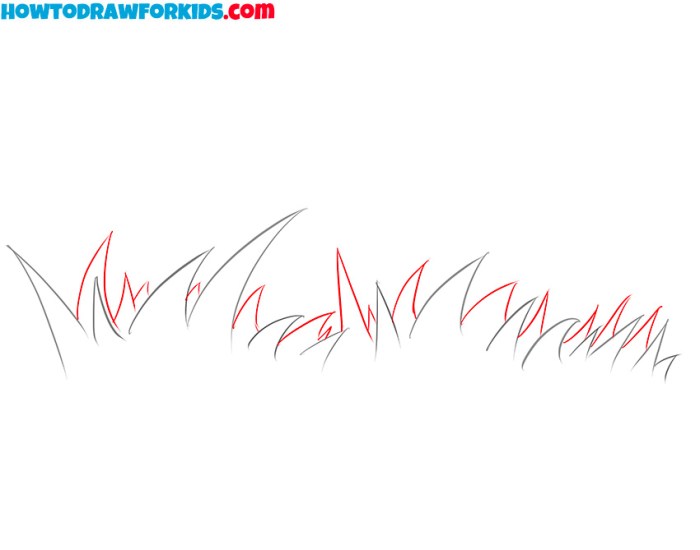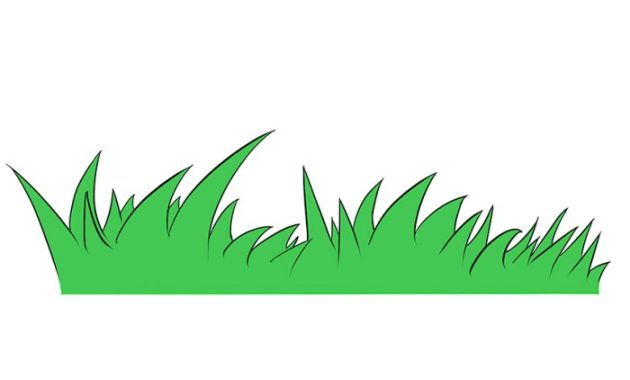Understanding Indian Grass

Indian grass easy drawing – Indian grass, with its evocative name, conjures images of swaying plains and whispering winds. But beyond the romanticism, lies a fascinating plant with unique characteristics that distinguish it from its grassy brethren. This exploration delves into the visual aspects, growth cycles, and comparative analysis of this remarkable species.Indian grass, scientifically known asSorghastrum nutans*, presents a captivating visual spectacle throughout its life cycle.
Its foliage displays a remarkable array of textures and colors, offering a rich tapestry to the observer.
Visual Characteristics of Indian Grass, Indian grass easy drawing
Mature Indian grass stands tall, often reaching heights of 3 to 6 feet, creating a sea of gently waving blades. The leaves are linear, typically 12 to 24 inches long and about ½ inch wide, with a slightly rough texture to the touch. Their color varies depending on the season and the specific cultivar, ranging from a vibrant, bright green in spring and summer to a rich golden-brown in autumn, providing a stunning display of seasonal transition.
The seed heads, appearing as plume-like panicles, are a key identifying feature, initially a greenish-yellow before maturing into a rich, bronze hue. These panicles are usually 6 to 12 inches long and densely packed with small seeds. The overall effect is one of graceful elegance, a dance of light and shadow as the wind moves through the tall stalks.
Growth Stages of Indian Grass and Their Impact on Appearance
Indian grass progresses through distinct growth stages, each dramatically altering its visual presentation. In spring, slender green shoots emerge from the ground, gradually unfurling into long, vibrant blades. Summer brings the full glory of the plant, with its mature height and dense foliage. The leaves reach their peak color intensity during this period. Autumn marks a dramatic transformation; the once-green blades gradually transition to a fiery orange, then a deep golden-brown, culminating in a breathtaking display of autumnal hues.
Finally, winter sees the plant’s above-ground parts wither and die back, leaving behind only the sturdy base, ready to regenerate in the coming spring. This cyclical transformation showcases the resilience and adaptability of the species.
Comparison with Similar Grasses
Distinguishing Indian grass from similar species requires careful observation. While it shares similarities with other tall grasses, several key features set it apart. For instance, compared to switchgrass (*Panicum virgatum*), Indian grass typically has a more upright growth habit and narrower leaves. The seed heads also differ significantly; Indian grass boasts dense, plume-like panicles, whereas switchgrass exhibits more open and airy seed heads.
Similarly, compared to big bluestem (*Andropogon gerardii*), Indian grass possesses a less robust and wider leaf blade. The seed head structure and overall plant height also aid in differentiation. Careful attention to leaf width, seed head structure, and overall plant architecture is crucial for accurate identification.
Basic Drawing Techniques for Indian Grass: Indian Grass Easy Drawing

Capturing the delicate sway and subtle textures of Indian grass on paper requires a keen eye and a gentle hand. This section will guide you through the fundamental techniques needed to bring this beautiful plant to life in your drawings, focusing on simplicity and achieving realistic effects. We’ll explore line work, texture creation, and shading methods to build a convincing representation of a single blade, easily adaptable to a larger composition.
Let’s embark on this artistic journey, step by step, learning to translate the essence of Indian grass onto your chosen medium.
Drawing a Single Blade of Indian Grass
Begin by sketching a long, slender, slightly curved line. This forms the central axis of your grass blade. Imagine the gentle wind causing the grass to bend ever so slightly. Don’t worry about perfection; a natural, flowing line is key. Next, add smaller, slightly irregular lines branching out from this central axis, creating the illusion of the blade’s width and texture.
These smaller lines should be shorter and thinner near the base, gradually lengthening towards the tip. The variations in line length and thickness contribute to a more realistic appearance. Finally, subtly taper the end of the blade to a fine point, mimicking the natural shape of Indian grass.
Creating Texture in the Drawing
Indian grass possesses a unique texture; sometimes smooth, sometimes slightly rough. To represent this, we’ll use a combination of line weight and short, hatched strokes. Where the blade appears smoother, use thinner, more consistent lines. For areas that seem rougher or more weathered, employ short, slightly erratic lines, closely spaced together. Imagine the sun catching the subtle bumps and grooves on the surface of the blade, and translate that into your drawing.
Varying the pressure on your pencil or pen will also enhance the texture. A lighter touch creates a smoother effect, while heavier pressure suggests a more prominent texture.
Shading Techniques for Indian Grass
Shading is crucial for adding depth and realism to your drawing. Several techniques can be employed to achieve a convincing representation of light and shadow on the grass blade. Each technique offers a unique aesthetic and level of detail. The choice depends on your personal preference and the overall style of your drawing.
Yo, drawing Indian grass is chill, right? Simple lines, easy breezy. But if you wanna switch it up, check out some totally rad tundra easy drawing animals for inspiration – those arctic foxes are fire! Then, you can bring that cool, minimalist vibe back to your Indian grass sketch, adding a unique touch. It’s all about that creative flow, man!
| Shading Technique | Description | Effect | Example |
|---|---|---|---|
| Hatching | Parallel lines drawn close together to create shading. | Creates a smooth, even tone; good for subtle shading. | Imagine parallel lines, like thin, closely spaced railroad tracks, running along the length of the grass blade, denser in the shadowed areas. |
| Cross-hatching | Two or more sets of parallel lines intersecting at angles. | Creates a darker, more textured tone; ideal for strong shadows. | Imagine the previous railroad tracks, but now add another set crossing them at a slight angle, creating a grid-like pattern. The density of the crossing lines determines the darkness of the shadow. |
| Stippling | Small dots of varying sizes and densities used to create shading. | Creates a soft, delicate tone; excellent for representing subtle light and shadow. | Imagine a constellation of tiny dots scattered across the grass blade, more densely packed in the shadowed areas to create depth. The size and spacing of the dots can be varied to create different textural effects. |
| Blending | Using a smudging tool or finger to blend pencil or charcoal strokes. | Creates a smooth, seamless transition between light and shadow. | Imagine softly blending the lines or dots to create a more fluid transition between the lighter and darker areas of the blade, softening the harsh lines of the previous techniques. |
Drawing a Cluster of Indian Grass

Imagine a gentle breeze whispering through a field, swaying a multitude of slender, elegant blades of Indian grass. Capturing this natural grace on paper requires understanding not just the individual blades, but how they interact within a cluster, creating a sense of movement and depth. This section explores the art of depicting a cluster of Indian grass, from a simple grouping to a more complex, realistic portrayal.A small cluster of Indian grass, delicately drawn, can evoke a feeling of quiet beauty.
Begin by sketching several blades, varying their lengths and slightly curving them to suggest a natural sway. Notice how some blades overlap others, creating a sense of layering and depth. The subtle intertwining of the blades, where they cross or partially obscure one another, adds realism. The base of the cluster should be slightly thicker, hinting at the density of the grass.
Consider using lighter pencil strokes for the blades that are further back, creating a sense of atmospheric perspective, where elements further away appear lighter and less defined.
Perspective in Indian Grass Clusters
Perspective is key to making a grass cluster appear three-dimensional and lifelike. Linear perspective, while not strictly applicable to individual blades, comes into play when considering the overall arrangement. Blades in the foreground will be drawn more distinctly, with detailed texture and individual characteristics. As the blades recede into the background, they become progressively smaller and less defined.
This reduction in size and detail gives the illusion of distance and depth. Furthermore, the use of value (light and dark) is crucial. Blades closer to the viewer will have more contrasting light and shadow, while those further back will appear more muted, contributing to the atmospheric perspective effect. Think of a sunlit field – the foreground blades will be brightly lit, while those further away will be in softer, less intense light.
Drawing a Complex Indian Grass Cluster
To create a larger, more intricate cluster, we’ll build upon the techniques already learned.
- Sketch a Light Artikel: Begin with a light pencil sketch outlining the overall shape and size of the cluster. Think of it as a loose, organic form, not a rigid geometric shape. Consider the overall direction of the wind or the natural curve of the cluster.
- Layering the Blades: Start adding individual blades, working from the background to the foreground. Use a variety of lengths and curves, avoiding uniformity. Remember to overlap blades to create depth and visual interest.
- Adding Detail and Texture: Once the basic structure is in place, refine the individual blades. Add subtle variations in thickness, slight bends, and delicate textures. Use varying line weights to suggest light and shadow. Some blades might appear more brightly lit, others partially obscured by those in the foreground.
- Refining Values: Carefully consider the light source. Add shading to create depth and volume. The side of the blades facing away from the light source should be darker, while the illuminated side should be lighter. This creates a sense of three-dimensionality.
- Final Touches: Once satisfied with the values and details, gently erase any unnecessary guide lines. You can add fine details, such as subtle variations in color (if working with colored pencils or paints) to enhance the realism.
By following these steps, and remembering the principles of perspective and layering, you can create a captivating and realistic drawing of a cluster of Indian grass, capturing its inherent elegance and natural beauty.
General Inquiries
What kind of paper is best for drawing Indian grass?
Smooth or slightly textured paper works well. Something that can handle both light and heavier pencil strokes is ideal.
Can I use colored pencils instead of graphite?
Totally! Colored pencils are great for capturing the subtle color variations in Indian grass.
How do I make my Indian grass drawing look realistic?
Focus on shading and texture. Observe real Indian grass to understand how light and shadow affect its appearance.
Where can I find reference images of Indian grass?
Google Images, Pinterest, or even taking your own photos are all great options!

